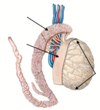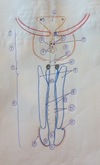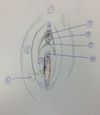...genital sytem Flashcards
(88 cards)
Differentiate btw male genetalia.
internal genetalia:
- testes + epidydimis
- ductus deferens + funiculus spermaticus
- accessory sex glands: prostate + gl. vesiculosa + gl. bulbourethralis (COWPER)
testes + epidydimus belong to int. genetalia bc they originate from abd. cavity, descended w/ peritoneal covering (cavitas serosa scroti) into scrotum
external genetalia:
- penis
- urethra
- scrotum
Briefly explain the function of the male genetalia.
- testes produce spermatozoa (∽ 74d)
- transported to epididymis → maturation (∽ 8-17d)
- pass through ductus deferens to urethra, sperms mixed with secretions of accessory sex glands
- leave body cavity through urethra
Describe the macroscopic structure of the testes.

- sup./inf. pole
-
epididymis
- 3 parts: caput, corpus, cauda
- fixed to sup. pole by lig. epididymis sup./inf.
- becomes ductus deferens at inf. pole
- covered by capsule = tunica albuginea
Briefly describe the microscopic structure of the testes.
What is their function?
seperated by septula testis into lobuli testes
→ contain seminiferous tubules
⇒ spermatozoa are produced in wall of seminiferous tubules
- in interstitium btw seminiferous tubules: LEYDIG cells → produce testosterone
Which remnants of embryological structures can be found in mature testes?
appendix testis:
- 3-4 mm wide at sup. pole
- remnant of MÜLLERIAN duct
appendix epididymis:
- at sup. pole of head of epidiymis
- remnant of WOLFFIAN duct
Which vessels supply/drain the testes?
Innervation?
supply:
-
a. testicularis (from aorta pars abdominalis)
orginate from lumbar region, follow during descencus
drainage:
-
plexus pampiniformis → unite in canalis inguinalis
→ v. testicularis dextra → v. cava inf.
→ v. testicularis sin. → v. renalis sin.
innervation:
- symph: plexus testicularis (rr. from plexus intermesentericus/renalis)
What is a varicocele and what might be the cause?
e. g. kidney tumors can grow into v. renalis → cause constriction of left v. testicularis →
* *dilation of plexus pampiniforis/vv. testicularis** → changes in blood circulation → reduced spermatic production
List the coats of the testes/scrotum from the innermost to the outermost layer.
-
tunica vaginalis = mesorchium
- epiorchium
- periorchium
- fascia spermatica int.
- m. cremaster
- fascia spermatica ext.
- scrotum - tunica DARTOS
- scrotum - skin
1 - 5
Which structures are formed by #2
No #4.
Another name for #3 and #5.

1) testes + epididymis
2) peritoneum → proc. vaginalis + deep ing. ring
3) epiorchium (visceral layer of tunica vaginalis)
5) periorchium (parietal layer of tunica vaginalis)
6 - 10

6) fascia transversalis abdominis
7) m. transv. abd.
8) m. obliq. int.
9) m. obliq. ext.
10) m. cremaster (prod. by #7 + #8)
11 - 16

11) fascia spermatica ext.
12) scrotum
13) tunica DARTOS
14) skin
15) cavitas serosa scroti
16) fascia spermatica int.
What is the function of tunica dartos?
movement of scrotal skin → temperature regulation (optimally 2 °C below body temperature)
Which structure can be found on the dorsal aspect in the middle of the scrotum?
raphe scroti = continuation of raphe perinei
What might be the reason for an innate inguinal hernia?
no obliteration of proc. vaginalis peritonei that forms tunica vaginalis testis
What is a hydrocele testis?
accumulation of fluid in cavitas serosa scroti → balloon-like enlargement
What can cause a testicular torsion and what are possible consequences?
thin mesorchium → testicular torsion → strangulation of blood vessels → irreversible damage to testes
What causes the cremaster reflex?
petting of inner surface of thigh → r. femoralis of n. genitofemoralis + cutaneous rr. of n. obturatorius → reflectory contraction of m. cremaster
What is cryptorchidism?
non-descent of testis into scrotum → stay in abd. cavity → high body temperature → damage to parenchyme of testes → no spermatic production
Which vessels supply/drain the scrotum?
Innervation?
supply:
- coats of testes: a. cremasterica (a. epigastrica inf.)
- scrotum: a. pudenda int.
drainage:
- v. pudenda ext. → v. saphena magna
- v. pudenda int. → v. iliaca int.
innervation:
- rr. scrotales of n. ilioinguinalis/n. pudendus
Which structures are connected by vas deferens?
How long is it, how thick?
Relate the structure of its wall to its function.
connects epididymis + urethra
- 35 - 40cm long
- 3mm thick
thick muscular layer → emission of sperms
What are the parts of vas deferens?
- pars epididymica ductus deferentis in inner aspect of epididymis
- pars funiculi spermatici in spermatic cord
- pars inguinalis in canalis inguinalis
- pars pelvica in lesser pelvis
then:
- ampulla ductus deferentis before entering prostate
- ductus ejaculatorius in prostate
- opens into colliculus seminalis of urethra
Which vessels supply/drain vas deferens?
Innervation?
supply:
- a. ductus deferentis (from a. umbilicalis)
drainage:
- plexus pampiniformis (cf. scrotal supply/innervation)
- *innervation:
- symph: plexus hypogastricus inf.
What are the layers of funiculus spermaticus?
from innermost to outermost
- fascia spermatica int
- m. cremaster
- fascia spermatica ext.
What are the contents of funiculus spermaticus?
-
vas deferens
- a. ductus deferentis
- plexus pampiniformis
- 2 aa. testiculares
- r. genitalis of n. genitofemoralis
- parasymph. fibers of plexus testicularis
- lymph vessels
<strong></strong><em>cf. histology flashcards</em>
- gl. vesiculosa: a. ductus deferentis (since more cran.)
- prostate: a. pudenda int. (since more caud.)

- gl. vesiculosa: a. ductus deferentis (since more cran.)
- prostate: a. pudenda int. (since more caud.)








2) symp. emission centers in L2/3 → emission
3) n. pudendus → ejaculation














